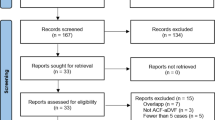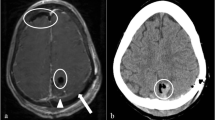Abstract
Purpose
Proximity to critical neurovascular structures can create significant obstacles during surgical resection of foramen magnum meningiomas (FMMs) to the detriment of treatment outcomes. We propose a new classification that defines the tumor’s relationship to neurovascular structures and assess correlation with postoperative outcomes.
Methods
In this retrospective review, 41 consecutive patients underwent primary resection of FMMs through a far lateral approach. Groups defined based on tumor-neurovascular bundle configuration included Type 1, bundle ventral to tumor; Type 2a-c, bundle superior, inferior, or splayed, respectively; Type 3, bundle dorsal; and Type 4, nerves and/or vertebral artery encased by tumor.
Results
The 41 patients (range 29–81 years old) had maximal tumor diameter averaging 30.1 mm (range 12.7–56 mm). Preoperatively, 17 (41%) patients had cranial nerve (CN) dysfunction, 12 (29%) had motor weakness and/or myelopathy, and 9 (22%) had sensory deficits. Tumor type was relevant to surgical outcomes: specifically, Type 4 demonstrated lower rates of gross total resection (65%) and worse immediate postoperative CN outcomes. Long-term findings showed Types 2, 3, and 4 demonstrated higher rates of permanent cranial neuropathy. Although patients with Type 4 tumors had overall higher ICU and hospital length of stay, there was no difference in tumor configuration and rates of postoperative complications or 30-day readmission.
Conclusion
The four main types of FMMs in this proposed classification reflected a gradual increase in surgical difficulty and worse outcomes. Further studies are warranted in larger cohorts to confirm its reliability in predicting postoperative outcomes and possibly directing management decisions.

© Glia Media, Artist: Tonya Hines, CMI

© Glia Media, Artist: Tonya Hines, CMI

Similar content being viewed by others
Data availability
The datasets generated during and/or analyzed during the current study are available from the corresponding author on reasonable request.
Code availability
No code was used for the purposes of this research study.
References
Ali MS, Algattas H, Zenonos GA, Wang EW, Snyderman CH, Gardner PA (2023) Endoscopic Endonasal Far-Medial Approach: 2-Dimensional Operative Video. Oper Neurosurg (Hagerstown). https://doi.org/10.1227/ons.0000000000000970
Arnautovic KI, Al-Mefty O, Husain M (2000) Ventral foramen magnum meninigiomas. J Neurosurg 92:71–80. https://doi.org/10.3171/spi.2000.92.1.0071
Bassiouni H, Ntoukas V, Asgari S, Sandalcioglu EI, Stolke D, Seifert V (2006) Foramen magnum meningiomas: clinical outcome after microsurgical resection via a posterolateral suboccipital retrocondylar approach. Neurosurgery 59:1177–1185; discussion 1185–1177. https://doi.org/10.1227/01.NEU.0000245629.77968.37
Bir SC, Maiti TK, Nanda A (2020) Foramen magnum meningiomas. Handb Clin Neurol 170:167–174. https://doi.org/10.1016/B978-0-12-822198-3.00038-0
Brumbaugh JE, Colaizy TT, Saha S, Van Meurs KP, Das A, Walsh MC, Bell EF, Eunice Kennedy Shriver National Institute of Child H, Human Development Neonatal Research N (2018) Oral feeding practices and discharge timing for moderately preterm infants. Early Hum Dev 120:46-52. https://doi.org/10.1016/j.earlhumdev.2018.04.001
Bruneau M, George B (2010) Classification system of foramen magnum meningiomas. J Craniovertebr Junction Spine 1:10–17. https://doi.org/10.4103/0974-8237.65476
Fatima N, Shin JH, Curry WT, Chang SD, Meola A (2021) Microsurgical resection of foramen magnum meningioma: multi-institutional retrospective case series and proposed surgical risk scoring system. J Neurooncol 153:331–342. https://doi.org/10.1007/s11060-021-03773-z
Fernandes MW, De Aguiar PHP, Galafassi GZ, De Aguiar P, Raffa P, Maldaun MVC (2021) Foramen magnum meningioma: Series of 20 cases. Complications, risk factors for relapse, and follow-up. J Craniovertebr Junction Spine 12:406–411. https://doi.org/10.4103/jcvjs.jcvjs_58_21
George B, Lot G, Boissonnet H (1997) Meningioma of the foramen magnum: a series of 40 cases. Surg Neurol 47:371–379. https://doi.org/10.1016/s0090-3019(96)00204-2
Khattar N, Koutourousiou M, Chabot JD, Wang EW, Cohen-Gadol AA, Snyderman CH, Fernandez-Miranda JC, Gardner PA (2018) Endoscopic Endonasal and Transcranial Surgery for Microsurgical Resection of Ventral Foramen Magnum Meningiomas: A Preliminary Experience. Oper Neurosurg (Hagerstown) 14:503–514. https://doi.org/10.1093/ons/opx160
Li D, Wu Z, Ren C, Hao SY, Wang L, Xiao XR, Tang J, Wang YG, Meng GL, Zhang LW, Zhang JT (2017) Foramen magnum meningiomas: surgical results and risks predicting poor outcomes based on a modified classification. J Neurosurg 126:661–676. https://doi.org/10.3171/2016.2.JNS152873
Morera VA, Fernandez-Miranda JC, Prevedello DM, Madhok R, Barges-Coll J, Gardner P, Carrau R, Snyderman CH, Rhoton AL, Jr., Kassam AB (2010) "Far-medial" expanded endonasal approach to the inferior third of the clivus: the transcondylar and transjugular tubercle approaches. Neurosurgery 66:211–219; discussion 219–220. https://doi.org/10.1227/01.NEU.0000369926.01891.5D
Paun L, Gondar R, Borrelli P, Meling TR (2021) Foramen magnum meningiomas: a systematic review and meta-analysis. Neurosurg Rev 44:2583–2596. https://doi.org/10.1007/s10143-021-01478-5
Shapey J, Vos SB, Vercauteren T, Bradford R, Saeed SR, Bisdas S, Ourselin S (2019) Clinical Applications for Diffusion MRI and Tractography of Cranial Nerves Within the Posterior Fossa: A Systematic Review. Front Neurosci 13:23. https://doi.org/10.3389/fnins.2019.00023
Yamahata H, Yamaguchi S, Takayasu M, Takasaki K, Osuka K, Aoyama M, Yasuda M, Tokimura H, Kurisu K, Arita K (2016) Exploitation of Simple Classification and Space Created by the Tumor for the Treatment of Foramen Magnum Meningiomas. World Neurosurg 87:1–7. https://doi.org/10.1016/j.wneu.2015.09.022
Acknowledgements
We are grateful to Mary Kemper for her guidance and expertise in preparation of this manuscript.
Funding
The authors declare that no funds, grants, or other support were received during the preparation of this manuscript.
Author information
Authors and Affiliations
Contributions
Conception and design: ASY, MKB. Acquisition of data: DAG, UE, OK. Analysis and interpretation of data: DAG, OK, MKB, ASY. Drafting the article: DAG, OK, RMP, ASY. Critically revising the article: DAG, RMP, OK, MKB, ASY. Reviewed submitted version: DAG, OK, MKB, ASY. Approved final version on behalf of authors: ASY, MKB. Statistical analysis: PWH. Study supervision: ASY.
Corresponding author
Ethics declarations
Ethics approval
This is an observational study. The University of Colorado, University of Wisconsin-Madison, and Geisinger University Ethics Committees have confirmed that no ethical approval is required.
Consent to participate
Owing to the retrospective and de-identified nature of this research, informed consent was not necessary to be obtained, in line with requirements of our institutions’ IRBs. This study did not affect standard of care treatment for these patients and consent to participate is not applicable.
Consent for publication
This is a retrospective study of clinical outcomes and patient data is entirely de-identified when used for data analysis. As such, a consent for publication is not applicable.
Conflicts of interest / Competing interests
The authors have no relevant financial or non-financial interests to disclose.
Additional information
Publisher's Note
Springer Nature remains neutral with regard to jurisdictional claims in published maps and institutional affiliations.
Rights and permissions
Springer Nature or its licensor (e.g. a society or other partner) holds exclusive rights to this article under a publishing agreement with the author(s) or other rightsholder(s); author self-archiving of the accepted manuscript version of this article is solely governed by the terms of such publishing agreement and applicable law.
About this article
Cite this article
Gattozzi, D.A., Erginoglu, U., Khanna, O. et al. Novel classification of foramen magnum meningiomas predicted by topographic position relative to neurovascular bundle. Acta Neurochir 166, 199 (2024). https://doi.org/10.1007/s00701-024-06091-1
Received:
Accepted:
Published:
DOI: https://doi.org/10.1007/s00701-024-06091-1




